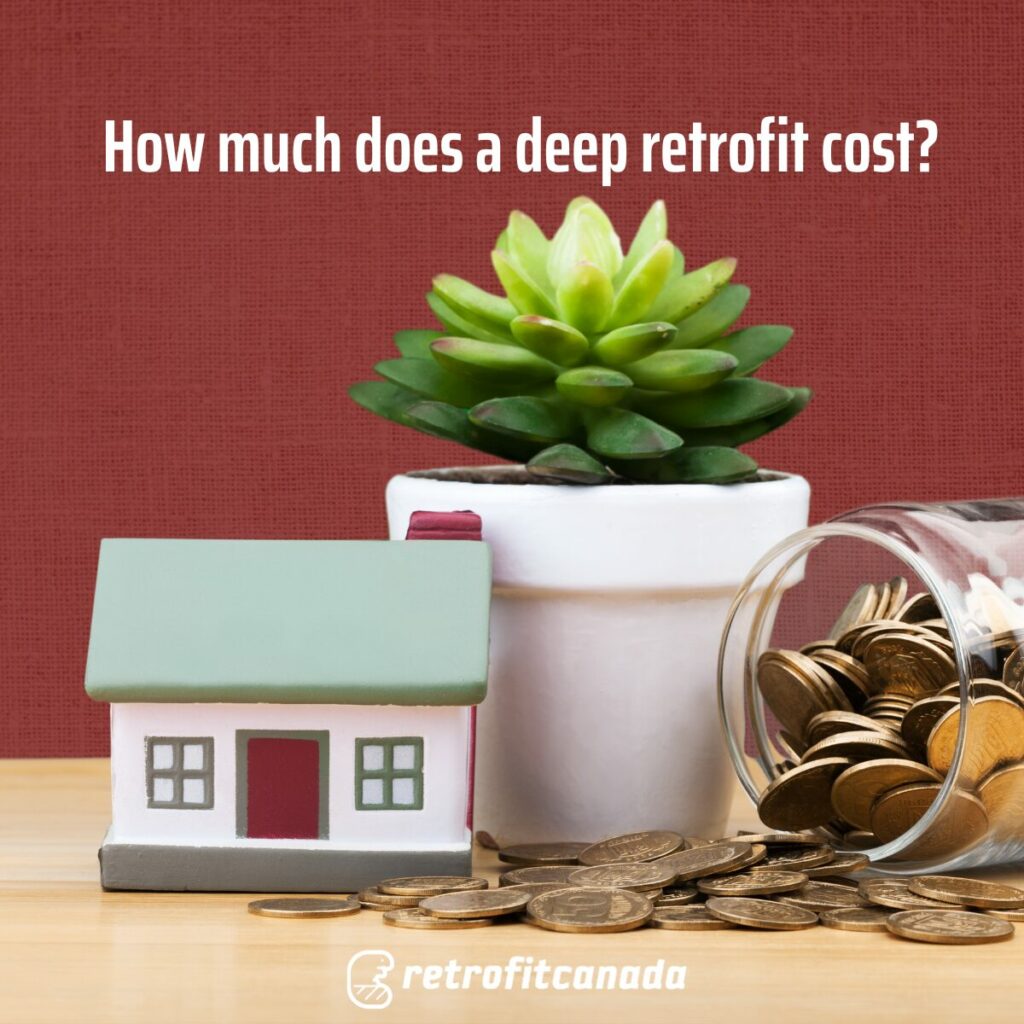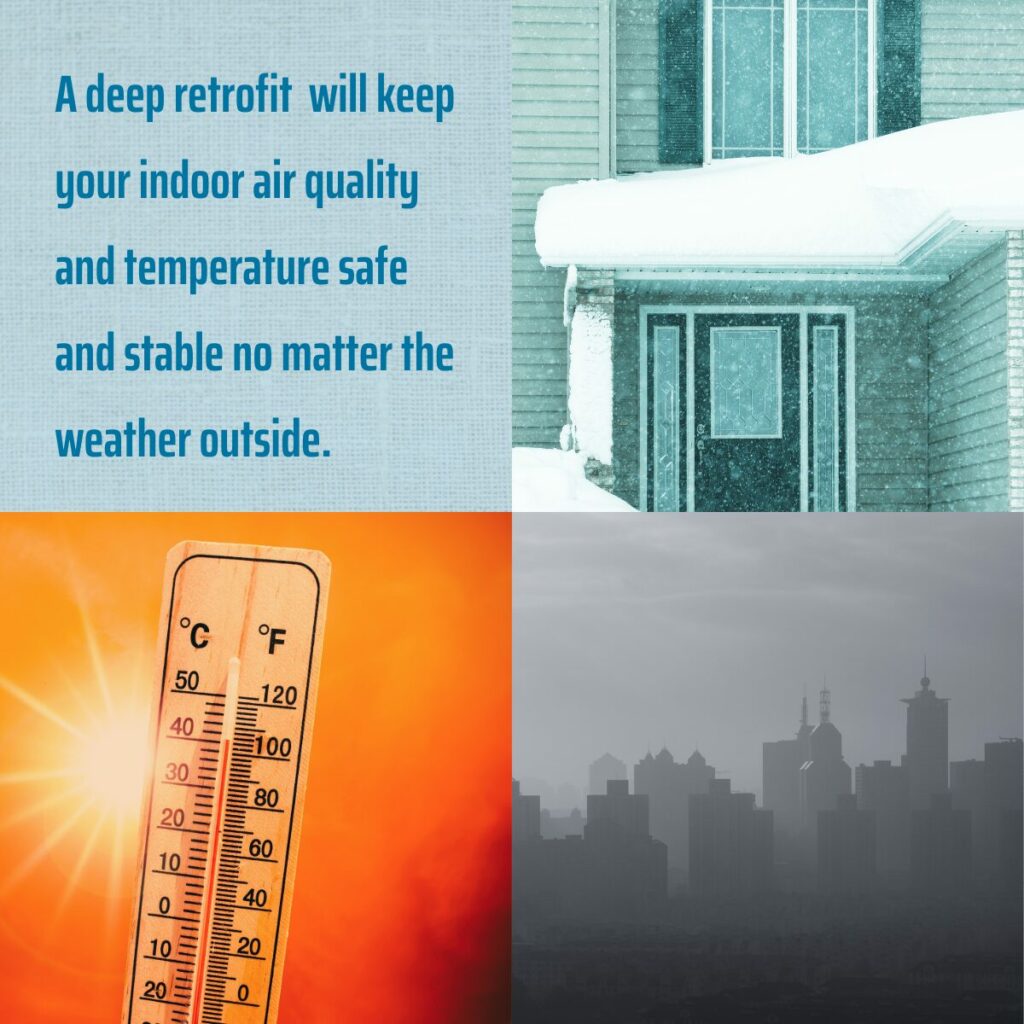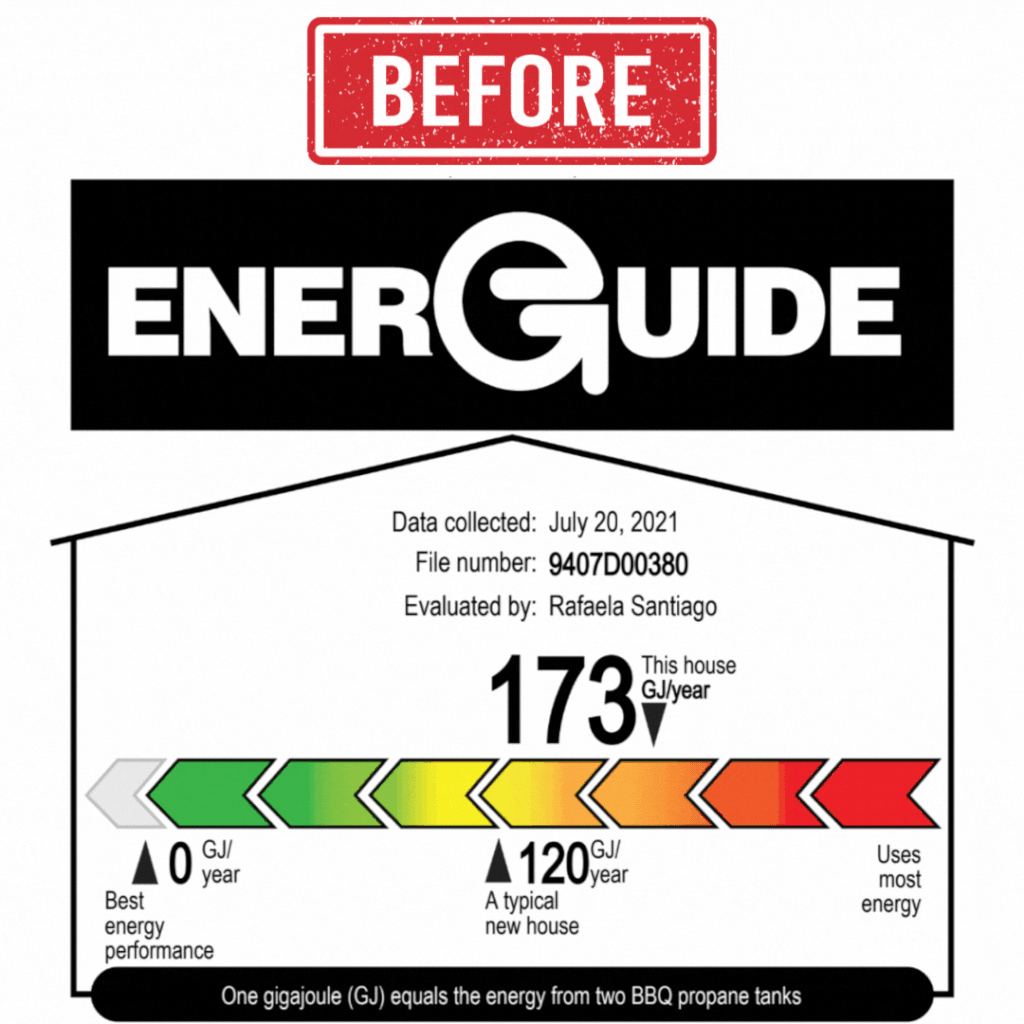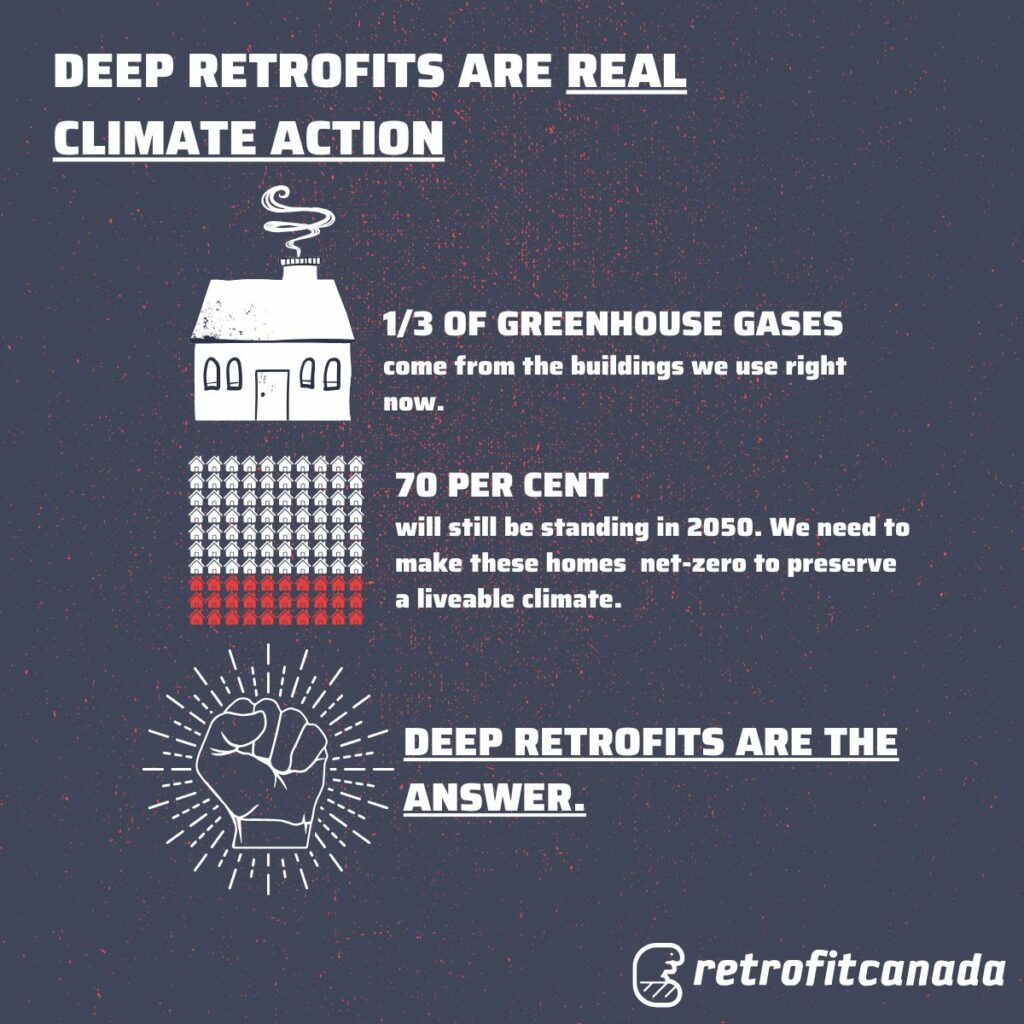
How much does a deep retrofit that makes a home net-zero ready cost?
That’s the number one question we get from consumers. So what’s the answer?
If you want to make an old house net-zero with a one-shot, all-in deep retrofit, you could be looking at costs of $100,000 to $200,000, but it depends on a number of factors.
A retrofit in this range likely includes a new basement-to-roof, super-insulated and airtight envelope, state-of-the-art HVAC equipment like heat pumps, a renewable energy source like solar, new high-performing windows and doors, new siding, and more. And there are many, many benefits to this all-in approach.
In this article, we’ll talk about the factors that affect costs and four things homeowners should know about deep retrofit costs, including whether you do a retrofit all in one shot or in a series of carefully planned stages.
What factors determine retrofit costs?
Building Specifications, Condition and Complexity
Every house is different – no one approach will work on every building. Of course, size matters. A small 800-square-foot bungalow that is essentially a box with a roof will cost less than a two-story, 2,500-square-foot home with all kinds of architectural details.
Do you have a basic roof, or does your roof have a lot of gables? Is the building a simple shape, or does it have complicated features? Do your eaves have enough overhang to accommodate an exterior retrofit that makes the walls thicker?
If you have already done an energy evaluation, what is the current efficiency of your home’s exterior envelope and HVAC? How far from net-zero is this baseline? What repairs or maintenance does your house already need?
Green building pioneer Peter Amerongen says these are complicated questions for most homeowners. He recommends working through them with qualified net-zero energy advisors and/or experienced net-zero renovators.
“These early efforts are very complicated and can seem really daunting. But we’re finding as we do more of these retrofits, and particularly as we get to the second version of a particular house type, they get a heck of a lot easier,” said Peter. “We envision the Retrofit Canada case study library to be a resource for many housing types as it grows.”
“As we do more of these retrofits, and particularly as we get to the second version of a particular house type, they get a heck of a lot easier” – Peter Amerongen
Renovation vs. Retrofit Costs
Jesse Tufts, a Project Engineer at ReNü Engineering Inc., has professional and personal experience managing all aspects of deep retrofits, including costs. According to Jesse, costs depend on several things, but one major factor is how many renovations and upgrades homeowners wrap into their deep retrofit projects. While doing as much work at once as possible is more efficient, it may also drive costs out of reach.
“When you’re planning a deep retrofit, it will be tempting to include other renovations and home upgrades that are not energy efficiency related.” said Jesse. “Maybe you include an addition or decide you want a kitchen renovation. Your deep retrofit can be a great opportunity to make your house into your dream home, but every upgrade or renovation is going to increase the overall cost, and this can lead to serious sticker shock when you get the work quoted.”
“Your Deep Retrofit can be a great opportunity to make your house into your dream home, but every upgrade or renovation is going to increase the overall cost” – Jesse Tufts
Homeowners planning a retrofit should take careful stock of which costs are related to the deep retrofit and which are “nice to haves” related to renovations or upgrades. These should be budgeted separately where possible so you know the minimum basic cost of your retrofit with no upgrades vs your ideal retrofit/renovation. With that information, you can make educated decisions about what’s in and out based on your budget.
The retrofit movement is emerging
There’s no perfect-for-every-house way to tackle a retrofit. There’s a shortage of companies and workers with hands-on experience doing deep retrofits. As a result, the retrofit industry is still scaling up. The expectation is that as retrofitters gain more experience and the number of deep retrofits increases across Canada, costs will go down.
Jim Sandercock, the owner of the first single-family home in North America to get an Energiesprong-inspired panelised deep retrofit, has experience with the realities of being an early adopter.
“Being first means your project is a guinea pig for answering the question, ‘How much does this cost?”’ said Jim. “As early adopters of this panelised retrofit technique, we expected some additional expenses. The project, like any renovation, needed real-time problem-solving for unexpected issues. This real-world research and development contributed to higher costs. We knew this going in and are thrilled with the results.”
Four things about deep retrofit costs
1. There are many, many benefits
When you do a deep retrofit that transforms your old home from a leaky, inefficient, GHG-emitting building to net-zero, there are many benefits. Your home will be 70 to 80 per cent more efficient, and able to get all its power from renewable energy sources. Done right, the exterior need only minimal maintenance for decades. Your old house will look like it was built yesterday but still have the character of an older home. The building will be able to withstand extreme weather conditions related to climate change. Your indoor air quality will be healthier. You and your family will enjoy nice, even temperatures throughout the house. You’ll be able to say goodbye to unpredictable utility costs, if you even have them. Finally, making your home net-zero is a practical way to contribute to climate action on an individual level.

2. Consider the Total Cost of Ownership

Even if your up-front deep retrofit costs may be higher than you would like, you will see a financial benefit as your total cost of ownership will be lower over time. Calculating the Total Cost of Ownership involves adding up all of your expected house-related expenses over the next 15 to 20 years. This includes factoring in the cost of maintenance that you would have to do anyway. For example, when will your roof be due for re-shingling? What about your HVAC equipment? A well-done retrofit can dramatically cut your list of required maintenance for years. If your retrofit includes recladding with a brand-new look, you also improve your curb appeal. And as home buyers increasingly look for net-zero and energy-efficient housing options, you will see your home’s value go up.
3. You don’t have to do it all at once, but you do need a plan!
You can do a deep retrofit in stages if you don’t want that higher up-front cost for a one-shot, all-in retrofit. We discuss staged retrofits in this article about different types of retrofits. A staged retrofit spreads the costs over time but will still make your home net-zero ready. It might take longer, and cost a little more in total, but may be easier for some homeowners to manage.
Now we want to be clear that doing it in stages means having a plan.
We absolutely, positively recommend against ever taking a piecemeal approach to retrofits. By piecemeal retrofit, we mean an approach where energy upgrades are done without treating the home as a system. The following are examples of a piecemeal retrofit:
- Adding attic insulation without first sealing it up to improve airtightness.
- Replacing the doors and windows with ones that are somewhat higher efficiency but not enough to get to net zero.
- When re-siding, not paying attention to airtightness or adding the optimal insulation for net-zero.
- Installing solar panels on a roof that really should have insulation added on top of it.
All of the above measures will save some energy, but, by themselves, can make achieving net-zero more difficult, or even impossible if they are prohibitively expensive to redo. This is why you need a comprehensive, well-thought-out plan for any retrofit to be effective and affordable.
The first step in planning is to get a home energy evaluation. This evaluation will tell you how energy efficient your home is right now. With that baseline information in hand, you can start the planning process.

The next step is to get a building condition assessment.
With these two pieces of information, it’s possible to dial in the right plan for your house, given your goals and its starting point.
If you can’t afford to do it all at once, it may be necessary to work out a plan where you can do the retrofit in stages in a way that nothing ever needs to be redone.
There are energy evaluators and contractors in most parts of the country who are learning to guide this process.
4. There is funding available
Thankfully, homeowners can access different funding sources and financing models that can help offset their costs. For example, the Government of Canada’s Greener Homes Grant may provide eligible homeowners up to $5,000 in funding for their retrofit. There are many other potential funding sources.
You can start your research using a tool like this one Natural Resources Canada has created that lets homeowners look up funding opportunities in their province.
Some jurisdictions in Canada even have deep retrofit advisors that can guide homeowners through the financial and practical considerations of a deep retrofit. And if you are working with a builder or other green energy professional, ask them for advice on funding opportunities or financing models.
Deep retrofit costs – final thoughts
Deep retrofits can come with a hefty price tag depending on several factors. You can spread these costs out over time with a staged retrofit, but remember that you need to have a plan to get your home to net-zero ready to make sure your upgrades work together and fit with your overall goal.
Finally, a deep retrofit done right has many benefits. When you consider these benefits along with your Total Cost of Ownership, and the fact that a deep retrofit is a practical way to take climate action, retrofitting your home is absolutely worth it.


